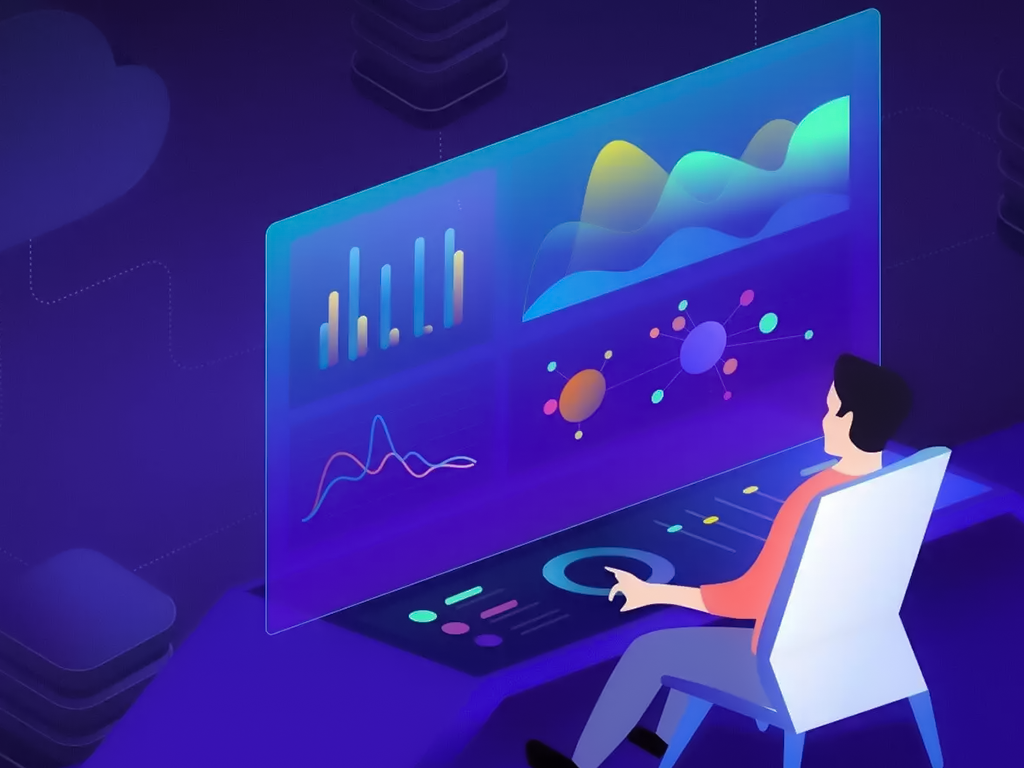Let’s Start
In today’s information age, we are bombarded with data from all sides. As a result, it can be challenging to communicate complex information in a way that is both informative and engaging.
The art of representing information visually is nothing but “data visualization”. It can be used to simplify complex data sets, identify trends, and tell stories. When used effectively, data visualization can be a powerful tool for enhancing your slide decks.
In the realm of presentations, a well-crafted slide deck can be a game-changer. Whether you are pitching to investors, delivering a corporate report, or presenting a project to your team, the effectiveness of your slide deck hinges on how clearly and compellingly you convey your information. One of the most powerful tools at your disposal is data visualization. By integrating data visualization techniques into your slide decks, you can significantly enhance the impact and clarity of your message.
The Power of Data Visualization
Data visualization transforms complex data sets into visual formats like charts, graphs, and infographics, making it easier for your audience to grasp key insights quickly. Rather than sifting through rows of numbers or dense text, your audience can instantly understand trends, patterns, and correlations through visually engaging elements. This not only aids in comprehension but also keeps your audience engaged and focused.
Benefits of Using Data Visualization in Slide Decks
There are several benefits to using data visualization in your slide decks. Here are a few of the most important:-
- Improves Clarity and Understanding: Data visualization can help to simplify complex data sets and make them easier to understand for your audience. By using charts, graphs, and other visual elements, you can help your audience to see patterns and trends that they might not have noticed otherwise.
- Increases Engagement: Data visualization can make your slide decks more visually appealing and engaging. A professional slide deck that includes data visualization is more likely to capture and retain the audience’s attention. Visuals are inherently more engaging than text-heavy slides, which helps prevent audience fatigue and keeps the presentation dynamic. By integrating compelling visuals, you create a more interactive experience that encourages active participation and retention.
- Boosts Persuasion: Data visualization can help to make your arguments more persuasive. By using data to support your claims, you can add credibility to your presentation and convince your audience of your point of view.
- Saves Time: Data visualization can help you to save time when creating your slide decks. By using pre-made templates and charts, you can quickly and easily create visually appealing slides.
- Simplify Complex Data: One of the primary benefits of data visualization is its ability to simplify complex information. When dealing with large amounts of data, textual explanations can be overwhelming and hard to follow. Visual representations, such as bar graphs or pie charts, distill this data into digestible formats, allowing your audience to grasp the essence of your message at a glance.
- Highlight Key Insights: Data visualization helps spotlight the most important points of your data. For instance, if you want to emphasize a particular trend or comparison, a well-designed chart or graph can draw attention to these insights without the need for extensive verbal explanations. This direct approach can be especially beneficial during high-stakes presentations where clarity and precision are crucial.
Best Practices for Using Data Visualization in Slide Decks

1. Choose the Right Type of Visualization:
Line charts are excellent for showing trends over time, while bar charts can compare categories. Pie charts represent proportions effectively. Selecting the appropriate type of visualization for your data is essential for conveying the right message. Ensure your visuals align with the specific insights you want to highlight.
2. Keep It Simple:
For effective data visualization, keep your slides simple. Avoid cluttering your slides with excessive data or overly complex graphs. A clean, straightforward design ensures that your audience can quickly interpret the information without being overwhelmed. Don’t overload your slides with too much data visualization. Focus on using a few key charts to illustrate your most important points.
3. Use Consistent Formatting:
Consistency in formatting helps in maintaining a professional look across your slide deck. Stick to a cohesive color scheme and font style to ensure your visuals integrate seamlessly with the rest of your presentation. Consistent formatting also aids in reinforcing your brand identity if you’re using a content creation agency like Pipaani for monthly content creation.
4. Integrate Data with Storytelling:
Data visualization should not just present information but also tell a story. Structure your data in a way that supports a narrative. Introduce your data with a brief context, use visuals to emphasize key points, and conclude with actionable insights. This approach helps in making your slide deck more engaging and memorable.
5. Test for Clarity:
Before finalizing your slide deck, test your data visualizations for clarity and effectiveness. Ask colleagues or stakeholders to review your slides and provide feedback on whether the visuals clearly convey the intended message. This peer review can help identify areas for improvement and ensure that your visuals effectively support your presentation objectives.
6. Use Clear Labels and Titles:
Make sure your charts are well-labeled and easy to understand. Explain what the data is representing with clear titles and labels.
7. Use Color Effectively:
It is important to use colors effectively. Avoid using too many colors or using colors that are difficult to see together.
8. Consider Your Audience:
When creating your slide decks, it is important to consider your audience. What is their level of knowledge about the topic? What are their expectations? Tailor your data visualization to the needs of your audience.
Examples of Data Visualization in Slide Decks
There are many different ways to use data visualization in your slide decks. Here are a few examples:
- Bar charts: Bar charts are a good way to compare different categories of data. For example, you could use a bar chart to compare the sales of different products or the market share of different companies.
- Line charts: Line charts are a good way to show trends over time. For example, you could use a line chart to show the growth of a company’s revenue or the unemployment rate over time.
- Pie charts: Example of a pie chart can be – using a pie chart to show the breakdown of a company’s budget or the market share of different companies in a particular industry.
- Maps: Maps can be a good way to show geographic data. For example, you could use a map to show the sales of a product in different regions or the location of a company’s customers.
- Infographics: Infographics are a combination of text, charts, and images that can be used to tell a story. Infographics can be a great way to present complex information in a visually appealing way. Explore our blog, “Infographics: Designing Eye-Catching Visual Representations with Pipaani” to learn more about infographics!
Leveraging Professional Slide Deck Services
Creating a high-impact slide deck that incorporates effective data visualization can be a challenging task. If you’re looking to elevate your presentations, consider partnering with a content creation agency specializing in slide decks writing services. Agencies like Pipaani offer subscription-based content services that include monthly content creation, ensuring your slide decks are not only visually compelling but also professionally crafted to meet your needs.
Pipaani, for example, provides expert assistance in developing PowerPoint slide decks that are tailored to your specific objectives. Their experience in creating professional slide decks ensures that your data is presented in the most impactful way possible, leveraging best practices in design and storytelling.
Conclusion
Incorporating data visualization into your slide decks is more than just a design choice; it’s a strategic approach to enhancing communication and engagement. By simplifying complex data, highlighting key insights, and maintaining a professional appearance, you can significantly boost the effectiveness of your presentations. Whether you’re handling a high-stakes pitch or a routine corporate report, data visualization can be your secret weapon for delivering a clear and compelling message.
Partnering with a content creation agency like Pipaani can further enhance your presentation efforts. With their expertise in slide decks writing services and subscription-based content creation, you can ensure your monthly content is not only engaging but also professionally crafted to achieve your goals. Get to know more about subscription-based content writing services by Pipaani by reading our blog, “Understanding Subscription-Based Content”!
Embrace the power of data visualization and watch your slide decks transform into persuasive and memorable presentations!
